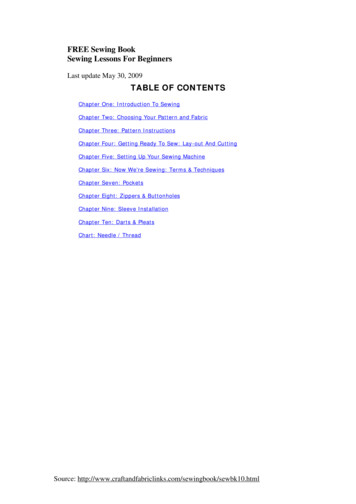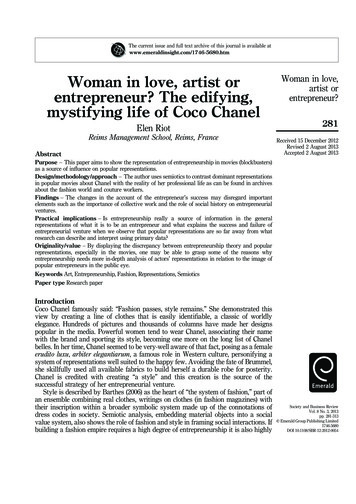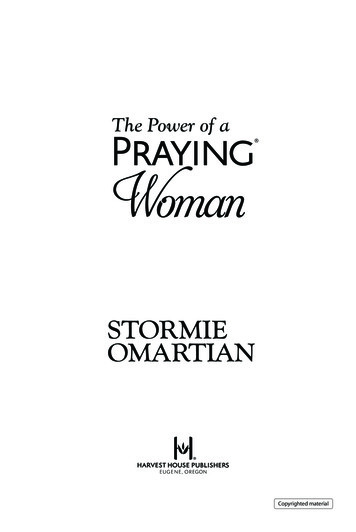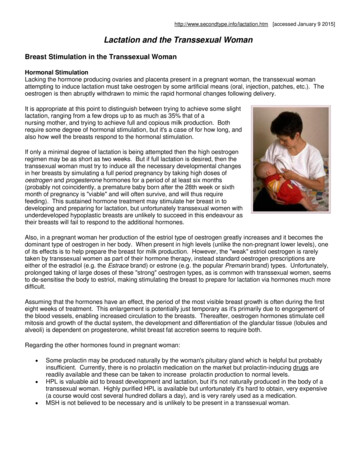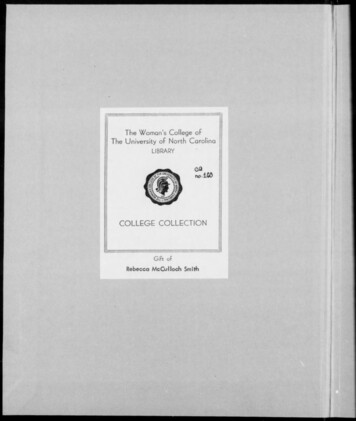
Transcription
The Woman's College ofThe University of North CarolinaLIBRARYno-lflOCOLLEGE COLLECTIONGift ofRebecca McCulloch Smith
THE DEVELOPMENT OF A UOLEJ.&KI NG UNITOn' L2THODS OF WORK SIMPLIFICATIONAS APPLIED TO HOIE TASKSbyREBECCA McCULLOCH Si THA thesis submitted tothe Faculty ofThe Consolidated University of North Carolinain partial fulfillmentof the requirements for the degreeMaster of ScienceGreensboro1952Approved by
ACKNOWLEDGEMENTSIt is with sincere appreciation that this writer wishes toacknowledge Dr. Josephine Kremer, director of the thesis, for herskillful guidance and inspiration, and Mrs. Madeleine B. Street andMrs. Cathryne B. Kehoe, for their interest and encouragement in thedeveloping of this thesis.
T&BLE OF CONTENTSP GECHAPTERI.II.INTRODUCTIONANDREVIEW OF LITERATURE1IffiTtiOD OF TEACHING UNIT6Teacher and Pupil Demonstrations on Posture Teacher and Pupil Demonstrations on SimplifyingHome Tasks2Dressing10Studying13Cleaning House13Preparing Food Laundering 16.17 19Sevang and MendingIII.APPLICATION OF WORK SI LIFI CATION AT SCnOOLAT HOiEAND21Application to the Home23 *.Planned Hone Experiencesv".21Application to the Homemaking Department and Foods Unit. .Spontaneous Uses of Work Simplification17.824.26EVALUATION OF THE UNIT BY TiiE PUPILS, MOTHERS AND THETEACHER35SUMt/IARY AND RECOMMENDATIONS37itethod of Teaching Unit and Findings37Recommendations to Teachers39Recommendations for Further Study47BIBLIOGRAPHYAPPENDIX4850
LIST OK TABLESTABLEI.II.PAGEHome Activities Kound Tiring by the High School Girl7Observations by Pupils of Methods .Ihich Made Tasks Difficultor EasyIII.IV.V./I.26Tasks Improved Spontaneously at Home During the Class Unit . .26Tasks Improved Through Planned Home Experiences29Evaluation of the Whole Unit36Summary of Pupil's Activity-it Various Stages of the Unit .ir sn ;r,40
CHAPTER IINTRODUCTION AND REVIEW Of LITERATUREWith the velocity at which the activities of the nation are increasing, the people who are trying to keep up with them are finding themselves in a state of nervous tension.Fewer households have servants andmore homemakers are working outside the home, causing the family to haveadded duty.This being true, more and more stress is being placed on worksimplification in order to reduce the time and energy used, thus givingmore leisure time and reducing these tensions.One reason that the increase in activities htsaffected people isthat "there is evidence that the little known of easier procedures fordefinite jobs in the home is not widespread."In the commercial field and in the eduoation field, steps have beentaken to apply principles of work simplification.Only in recent years,though, have homemakers begun to apply the various industrial methods ofwork simplification to their own home tasks, the reason being stated byGross and Crandall.The problem of controlling output of the homemaker is morecomplex than that of industry, for she must see the day as a whole,not as an eight hour workday} her work includes many varied tasksinstead of one specialised one, the wage incentive is lacking- andher work involves close personal relations with other people.1Practice.2Irrna H. Gross and E. W. Crandall. Home Management in Theory andNew Yorkt Appleton-Century-Crofts, Inc., 1947. p. 222.Ibid., p. 164.
To be able to help the homenakers make their taaka easier they notonly must learn new ways of performing tasks but they must become so interested in work simplification that they are able to apply one principleto many tasks.Gross and Crandall said it in thiB wayiFor the average person, work simplification can be of help intwo ways. First, a worker may actually use the results of laboratorystudies, that is, learn easier methods on a particular task. .The second kind of help is more far-reaching and more challenging.When interest is aroused in the subject anyone may become "motionedminded." What is motion-mindedness? Nothing more than the constantapplication of some general principles of work simplification to one'sown jobs. It is a point of view that adds interest to routine tasksand makes those tasks less of a burden.''Very little formal instruction has been presented to the publio ofmethods of work simplification and "up to the present time, researchstudies in relation to work simplification in the home are very limited."Findings of the Purdue Conference on Work Simplification held in August,1943, were probably the first made available to those actively engaged inhousehold tasks*The best known research in the field of work simplification has beendone by Frederick Taylor in The Principles of Scientific Management, 1911,and Frank Gilbreth in Applied Motion Study, 1917, but their work pertainedto industry.Mrs. C hristine Frederick in The New Housekeeping, 1914, andMrs. Lillian Gilbreth in The Homemaker and Her Job, 1927, applied theprinciples of work simplification to household tasks.Later research inindustry was made by Dr. Marvin Mundel in Systematic Time and Motion Study,1947, when he classed the changes in motions into five levels.3Ibid., p. 222.4Ibid., pp. 201-202.Gross and
Crandall adapted these changes to household tasks in this wayiClass 1 (lowest) Change in body position and number and typeof motions, everything remaining the same. Example siputting away dishes with two hands instead of one; sittinginstead of standing; eliminating unnecessary motions suchas useless pats while making a bed; using rhythmic motionsin sweeping*Class 2 Change in tools and equipment. ExampleBt a tray to carrydishes, a long-handled dusting tool, an electric mixer, aworking surface of the right height, the electrolyticmethod of cleaning silver.Class 3 Change in production sequence* Examples! method of bedmaking mentioned above in which all covers are tucked inon one side before worker goes to opposite side; mixingcake by putting a]l ingredients into bowl at once*Class 4 Change in finished product. Example si square biscuitsinstead of round ones cut with a biscuit cutter; leavingsheets unironed; closing a piano between usages to avoiddust; putting away brio-a-brao.Class 5 (highest) Change in raw material. Examples! selfpolishing wax; dirt repellent finishes on textiles;plastic place uats instead of linen; Swiss chard insteadof spinach (larger leaves take less handling)*Mary K. Heiner and N. M. Vedder made a study on dishwashing in 1930,"Studies in Dishwashing thodsiAn Attempt to Apply "Methods of JobAnalysis to a Household Process," and Heiner, in later research (1943),studied the type of tools and working conditions in the home.MarianneMuse made another study in 1934 on Kitchen Equipment and Arrangement.Themost soientifio research ever conduoted in the application of methods ofwork simplification to home tasks was made by Elaine Knowles in ironing ashirt (1944).Relatively little research has been done on the subject of teaching6Ibid,pp. 222-223.
a unit on work simplification to high school pupils.Closely related re-search was done by Kathleen iucDonald in her thesis, "Home ManagementTeaching on the Secondary Level."6In this study, she interviewed homeeconomics teachers in Alabama about the preferred method of teaching homemanagement.It was found that there is a definite trend toward summarizingmanagement in a short unit after integrating methods of work simplificationin each unit.The teaching techniques used were participation in theclassroom, demonstrations and discussions, supervised study, home projectsand lecture.About half of the teachers have found home project work aneffective means of teaching management*Since high school girls feel many pressures for their use of time,it seems important to help them with this problem.The teaching of methodsof work simplification as one separate unit is not a custon.in the home-making classes in North Carolina as it is included in all units throughoutthe Guide to the Teaching of Homemaking in North Carolina Schools.7Thewriter preferred to develop a unit on the subject.With this in mind, a unit on methods of work simplification consisting of pupil demonstrations and home experiences as applied to hometasks was developed and wa6 taught to a third year homemaking class of 19pupils at Randleman High School in Randolph County, North Carolina. McDonald, Kathleen, Home Anagement Teaching on the Secondary Levelin Alabama Polytechnic Institute, piaster's thesis. Alabama. AlabamaPolytechnic Institute, 1S47, 81 pp.7Dennis, Catherine T., Lacey, Uabel L., and Lowe, Louise, A. Guideto the Teaching of Homtimaking in North Carolina Schools. Raleigh, "North Carolina, State Superintendent of Public Instruction.
The purpose of the 3tudy was to develop the pupils' ability to applythe principles of work simplification to various tasks at home.A question-naire was used as a means of obtaining information about which tasks thepupils felt were tiring before they had been formally subjected to methodsof work simplification.An application of the knowledge gained was made through a change inthe homemaking department and home experiences, both spontaneous andplanned.Reports by the pupil and home visits by the teacher were means ofchecking the application to the home.
CHAPTER IIIJBTdOD OF TEACHING THE UNITA work simplification unit was planned and taught to a third yearhomemaking class and was evaluated.laThe objectives were to gainiAn awareness of the factors contributing to fatigue andan ability to recognize those things that hoinemakers dowhich cause unnecessary fatigue in household tasks.2.An understanding of the effect of posture, arrangement offurniture and equipment, sequence of work, and type of toolson lessening fatigue.3.An ability and a desire to correct factors causing fatiguein household tasks.In order to find the kind and number of household tasks that highschool pupils found most tiring, a questionnaire was used.Fifteen ofthose tasks often performed by boys and girlswere included in thequestionnaire; none were added by the pupils,iiost of the pupils foundironing, studying and dish washing tiring before having been subjected tomethods of work simplification (Table I).Mending and washing clothes werechecked only once each but it is felt that this may be due to the smallamount of it that high school pupils do.1 The tasks included were found by Elizabeth Winston to be frequentlyperformed in Home Activities, Matives, and Attitudes of Seventh and SighthGrade Pupils in the Different Types of Public Schools in North Carolina.Waster's Thesis. North Carolina, Woman's Colloge of the University of NorthCarolina, 1951.
TABLEIHOMS ACTIVITIES POUND TIRING BY TII3 HIGH SCHOOL GIRL(19 pupila in a third year homemaking olass at Randleman HighSchool, Randolph County, liorth Carolina)ActivitiesNumber of pupils checkingtasks as tiringIroningStudyingWashing dishesDressingCutting patternMaking bedsPreparing a mealCleaning a roomHanging out and bringing in clothesSowingCleaning windowsPreparing one food in particularSetting the tabletendingWashing c/oMes1587655544433311Three parts of varying length were planned to show the relationshipof posture, sequence of work, arrangement of furniture and equipment, andtype of tools to ease in homemaking.Part one (one lesson) attempted to gain interest in the eliminationof fatigue in the performance of household tasks, by the use of the motionpicture, "USDA Step-Saving Kitohen."Part two (five lessons) attempted!(a) to gain pupil understandingof the relation of posture to fatigue, (b) to develop knowledge of the typesof posture which require the most energy, (c) to develop pupil ability touse correot posture for doing tasks when standing, sitting, walking, bending,stooping and reaching, and (d) to gain pupil knowledge of relaxing exercises*
8Part three (ten lessons) was planned to continue the study of factorscontributing to fatigue by bringing out the elements other than posture sequence of work, arrangement of furniture and equipment, and type of tools.Teacher and Pupil Demonstrations on PostureOne poster of photographs snowing good and poor posture for doingworic while standing, sitting, walking, and stooping, and another postercomparing the energy required in lying down, sitting, standing, stooping,and reaching were discussed.Determination of good posture by means of aplumb line was also included in this lesson.The teacher demonstrated bestposture to maintain while completing a task requiring standing and walkingpostures; for instance, beating or mixing, ironing, washing dishes and thelike.To develop pupil knowledge of correct sitting, stooping, reaching,and bending postures in doing tasks, the class of 19 pupils was dividedinto five groups; each group to study and to demonstrate a part of the tasksrequiring these postures.The first group studied and demonstrated correct posture whilesewing, cleaning walls, getting items from high shelves, and dusting.The second group studied and demonstrated correct walking posturefor mowing the lawn, moving furniture and using the vacuum cleaner and itsattachments.Demonstrations showing correot posture when carrying heavy objects,sitting while working in the kitchen, and looking into ovens or low placeswere presented by the third group.The fourth group studied and demonstrated correct posture for
lifting heavy articles, picking up smaller articles and opening windows.Relaxing exercises were studied and demonstrated by the last group.Teacher and Pupil Demonstrationson Simplifying Home TasksIn preparation for studying the factors affecting the time andenergy used in carrying out various tasks, a mimeographed list, which grewout of the first questionnaire, was prepared to show the tasks which weretiring for these pupils and to break them down into small unitsjDressingArrangement of dresser drawersClothes storageBathroom arrangementStudyingDesk and storage of booksCleaning houseOrder of cleaning a roomUsing vacuum cleaner and its attachmentsCleaning windowsFurniture arrangementleaking bedsGarden tool and hardware storageWashing dishesCleaning silver (not chosen for study later)Other storage problems (not chosen for study later)Preparing foodCake baking (or other food)i uick mealsTable settingKitchen arrangement and equipmentlaundryStorage of soiled and clean laundryHanging out and bringing clothesIroningSewing and mendingCutting of patternPlacement of machineStorage of notions
10The teacher chose one small unit and demonstrated to the class waysin which this element of the task could be done more easily, applying theprinciple of chance in arrangement of equipment.To be able to gain andhold pupil interest by actual participation and to enable all units to becovered, each pupil chose one unit, studied the factors affecting fatigue,and presented her findings to the class in demonstration form.The teacherhad prepared a bibliography of books, pamphlets, and clippings, separatedaccording to task and placed in folders accessible to the pupils.Theteacher had also prepared a mimeographed sheet to help the pupils organizetheir demonstrations, which provided for listing the factors which madethis activity tiring, time-consuming, or inconvenient, and the reasons;as well as the changes made which improved the way of doing the activity,listing references and making drawings when possible (page 11).A descrip-tion of demonstrations by the teacher and pupils followsiDressingDresser drawer arrangement.Two similar drawers from a dresser wereplaced on exhibit by the teacher, the contents of each arranged very neatly.Only one, showed the correct way, as was pointed out by a poster above theexhibit.The correct drawer was far better because of a sectioned utilitydrawer and other small boxes to hold hairpins, combs, hairnets, lipstick,and the like, thus keeping everything in place even with the movement ofpulling out and pushing in the drawer, and taking out and putting in articles,There were no jars, tubes, and boxes of any cream or powder duplicated nor
11DEMONSTRATION OF MAKING TASKS EASIER1.NAME OF ACTIVITY2.LIST FACTORS WHICH MAKE THIS ACTIVITY TIRING OR TAKE TOO MUCH TIJ.EOR INCONVENIENT.3.a.WHY?b.WHY?o.WHY?d.WHY?LIST CHANGES MADE WHICH I!'T"ROVED ACTI/ITY SO THAT IT IS LESS TIRESOMEOR TAKES LESS TIME OR y5.Drawings, if possible
12were there any jars with only a small portion in them.The poorer drawer,though arranged well was holding duplicate cosmetics, hairpins lying in aneat pile, lipstioks lined side by side and such other things that wouldbecome jumbled instantly should the drawer be moved.This caused much comment as many persons said, "That's my drawer,"pointing to the poor one.Many spontaneous home experiences grew from this.Two teachers who saw the exhibit said that they went home and rearrangedtheir dresser drawers.Clothes closets.In t.iis demonstration, the ordinary way of makinguse of clothes closets was shown by a drawing on the blackboard, with onlyhooks and a very high shelf.Ways to change a oloset by adding low shelvesalong one side, shoe racks or shoe bag6, belt hooks, and putting up a rodwere demonstrated.For those whose problem was the lack of a clothes closet, ways ofmaking a closet from a refrigerator shipping box, from apple boxes placedin two stacks with a board and rod connecting the two stacks and anotherfrom a rod attached to two upright boards similar to a bench.Bathroom storage.Three conventional small bathrooms were drawn onthe blackboard to show storage ideas.One consisted of shelves in thewalls, and/or extending out into the room wherever they did not obstructwalking space, as above the flush tank of the commode.A larger bathroomwas also drawn to show the added convenience of more storage space sincetowels, soap, toilet supplies, soiled clothes and sometimes underwear areoften used there first.
15For bathrooms which lack built-in storage, a mov able set of drawers,shelves or table were suggested as added storage space.The importance ofhaving places for children's articles .Mas also brought out.StudyingDesk and storage for books.A table used in the demonstration wasproved to be the quickest way to provide a desk, but one which would bemore convenient and induce more pride could be made from an old bureau orapple boxes or orange crates with plywood connecting them for a top.Thiswould give excellent storage for books, and a divided shelf would providespace for vertical filing.Wany pupils felt that they would do more studyingif" they had a desk and a place to store their books and supplies.Cleaning HouseOrder of cleaning a room.No one of the class knew that the way inwhich one went about cleaning a room oould change the ease of cleaning untilit was demonstrated.periences.Then it became one of the most popular of home ex-The dining room was previously set up to resemble a den withpapers, shoes, ash trays and books for this demonstration.The room wasfirst cleaned by sweeping, picking up things as they were reached and carrying them to their proper room or plaoe, one at a time.Afterward, this same room, in its original clutter was cleaned byclearing tables, carrying out articles all at one time and emptying ashtrays into a paper bag ready for discarding.To make house cleaning easier,the suggestion was ne.de that some work be done every day instead of leaving
14it for a weekly task.Using the -vacuum cleaner and attachmenta.Using the den set up inthe dining room again, it was shown how dust is merely rearranged when thedust cloth and broom are used.It was also shown that regular use of thevacuum cleaner and attachments makes furniture last longer as dust is drawnout into a bag for discarding.Cleaning blinds regularly with extension attachments proved easy andkeepsthem cleaner longer.Since attachments are not used extensively byhomemakers through lack of convenient storage places, an apron-like holderwith pockets was made and shown to the class.The pupil taught that thisholder should be kept near the storage place of the vacuum cleaner.Cleaning windows.As one window was cleaned, the demonstratorstressed the more difficult way by use of soap and water, not washing woodwork first, and by standing on a chair with a bucket of water on the floor.Another window was cleaned with a sprayed on window cleaner and a soft clothand use of a step ladder for higher panes.The woodwork was cleaned with asoapless cleaner before the windows were washed.Before the demonstration, some comments indicated the feeling thatsoap and water was cleaner, but after the demonstration, the thought waschanged because of the smaller amount of work required as well as thecleaner, less streaked windows.Furniture arrangement.By the use of a large doll house and dollfurniture, it was shown that ill-arranged furniture hampered house cleaning.Bookshelves over a wide piece of furniture, no clear passageway, furniture
15which has to be moved and a bed against two walls were the main faultsbrought out in the demonstration as causing too much energy to be expendedin housecleaning.The furniture was rearranged in the same room showinghow it looked better as well as was easier to clean.Making beds.When a person has never been shown the easy way tomake beds, it is hard for them to grasp it by reading the directions, sothe teacher showed the pupil how to demonstrate bed making the old way andthe new way, counting time and motions and steps.brought out as a factor in wasting energy.The height of the bed wasUsing this information from theteacher, the demonstration was started by showing the old way of puttingeach cover on and arranging it on both sides before putting on the nextcover.Immediately, this bed was remade by using the method of completingone side and then the other, saving numerous steps.This demonstrationalso caused many spontaneous home experiences.Garden tool and hardware storage.In this exhibit of garden tooland hardware storage, glass jars were on display holding different sizes ofnails, nuts, bolts and the like.A large board indicating the back of adoor or a wall was used in the demonstration to show how to hang such toolsas pliers, hammers, saws, and screw drivers, in preference to their beingall jumbled up in a tool box.Pictures were shown on how to store gardentools.Washing dishes.This demonstration was shown in the homemakingdepartment kitchen where the only sink is too low for any pupil enrolled inhomemaking.There is no cabinet near the sink.The demonstrator used this
16to advantage by showing how to use a tray for carrying dishes to and fromthe sink, and by raising the dish pan with another pan turned upside downunder her dish pan.The convenience of having the dish pan, soap, and allthe dishwashing apparatus at the sink was also shown.Proper sequence ofwork was 6hown by taking dirty dishes, stacked at the right, to the dish pan,to the drainer at the left and into an improvised dish cabinet, since nocabinet was near the sink in this department.Preparing PoodCake baking.Three points were brought out by the demonstrator;the difference in number of utensils necessary for making a cake by a reciperather than a cake mix, the use of the electric mixer rather than handbeating, and collection of all utensils first rather than starting cake andgetting ingredients and utensils as needed.To make these points, a table was set up with utensils necessary formaking cakes with a recipe on one side and with a cake mix on the otherside.Then two small cakesIron cake mix were madeithe pupil (l)collecting utensils and ingredients as needed, using a great many steps and(2) using a tray to collect everything at once and make the oake withoutmoving many steps.By using an assistant, the difference in energy was shown by mixingtwo small cakes, one by hand, and one by the mixer.mixer and the storage of other tools were discussed.The placement of theIt proved the pointwell.Preparation of a quick meal.A breakfast was used in this demon-
17stration to show points leading up to time required in preparation of ameal*After a short talk on planning ahead, buying groceries in quantity,placement of equipment, and knowing recipes, a breakfast of juice, bacon,eggs, and toast, and coffee was prepared in a matter of minutes, by thepupil.Setting the table*The dining room in this horaemaking departmentis 20 feet away from the nearest unit kitchen.In the demonstration, atray was used to collect dishes to take to and from the table.There werehints on cupboard arrangement, stacking dishes of like sizes together andhaving only the numoer of plates, silver, saucers and the like, usuallyused at the family meal.Arrangement of large equipment and placement of tools in the kitchen.This demonstration followed others on food preparation as a sumaary ofpoints brought in the first three, as well as adding a few more suggestionsfor work simplification.Pictures of shapes of kitchenB and arrangement oflarge equipment for better sequence of work were used to start the demonstration.Then it was shown how old kitchens could be rearranged to permiteasier work.After this, each work area was disoussed as to what should bestored there and in which position.A picture showing how to make verticalfiles for storing lids, trays and the like was passed around for all to see.LaunderingStorage of soiled and clean laundry.most of the demonstration.Pictures and discussion made upThe pupil made the suggestion that every person
18should have his own soiled clothes bag in his own room as a means of keepingone box or basket from overflowing with the family's laundry.The picturesshowed ways to put shelves in a linen closet and how to make a dirty clothesbin that pulls out from the wall.Hanging out and bringing in clothes.in the family wasTwo of each type of articlebrought to this demonstration.A line was stretchedacross the room at the height of one's upstretched arms.The demonstratorfirst hung up the clothes which were in a basket placed oa the floor.Agreat amount of energy was wasted in the motions of having to lean over toget the clothes and pins and then hang them up at far above shoulder level.The line was then la. ered to shoulder level, the basket of clotheswas placed on a table with rollers and the clothes were hung up in such away as to make ironing easier.she worked.clothes.A11points were brought out by the pupil asA clothes pin apron was used as an aid to easier hanging outAfter the clothes were hung up they were taken from the line, mostof them being folded for no further ironing.ironing would be easier.The others were folded so thatThese dry clean clothes were placed in the basketon the roller table to be carried into the house.The duplicate basket of clothes, in a disorderly pile, was then compared with the folded ones to show the difference in ironing hours.Ironing.The same day the ironing demonstration was shown.Anironing board and a stool in the center, a chair with a basket of sprinkledclothes and folded dry clothes to the left and a chair for flat work and arack for hanging shirts on the right were on exhibit.The demonstrator
19ironed one garment showing how to iron using slow strokes as well assequence of work.After this, an article of clothing was obtained from a table on farside of the room, ironed while standing with many quick strokes and muchhandling of the garment, then carried to a closet in another room to hang;proving waste of energy in such a method*Sewing and tendingCutting of pattern.The three places generally used by the home-makor when cutting a pattern - the floor, the bed, and a table - were allused in the demonstration by the pupil.After showing that it was easierevery tine the height was raised, she pointed out that even a standardheight of 36 inches was not correct for most people,* height slightlybelow the elbow proved to be less straining on the back.To reach thisheight the table was raised by putting blocks under the legs.The samepupil also gave the following demonstration; she was the only pupil who gavetwo demonstrations.Placement of machine.A picture of a U-shaped sewing center with theironing board on the left, machine in the center, and a cabinet holdingnotions and patterns on the right was shown to the class.A talk on placingthe machine in good light, on a hard floor, and in an easily accessibleplace, followed the showing of the picture.Storage of notions.A 1* x 1' pasteboard box, sectioned off by card-board was shown to be a convenient place to store patterns, separating suit.m
20dress, and pajama patterns in different sections.small boxes side by side was shown.Another box fitted withEach small box was filled with thread,needles, pins, tape measures, scissors and everything necessary for sewing.A machine drawer or other drawer that could be set aside for anotions drawerand outfitted with dividing boxes was brought out as anotheridea of convenience.
CHUTER IIIAPPLICATION OF WORK SIMPLIFICATIONAT SCHOOL AND AT HOi.EAfter the class unit had been taught, the pupils applied the principles of work simplification to real situations.They applied their know-ledge to the hoinemaking department by ohanging it for more convenience.Inthe foods unit following this unit, there was evidence of methods of worksimplification being used.At home, the pupils spontaneously made somechanges in their tasks and they each planned and carried out at least oneimprovement in their home tasks.Application to the Homomaking Departmentand Foods UnitThere was a class problem in the application of the principles ofwork simplification to the horaemaking department.The department has threerooms - a sewing laboratory, a foods laboratory, and a dining room, as wellas two large closets.The class was divided, placing a group in each of thefive areas of the department.venience and needs.At first a survey was taken of the incon-A class discussion after this brought forth manysuggestions for improvements in the five areas.
in partial fulfillment of the requirements for the degree Master of Science Greensboro 1952 Approved by . . both spontaneous and planned. Reports by the pupil and home visits by the teacher were means of . An ability and a


